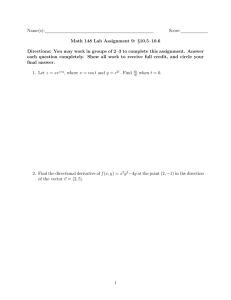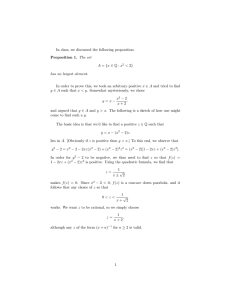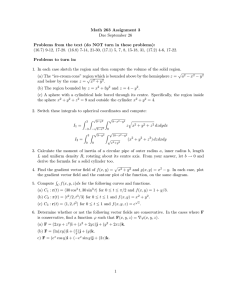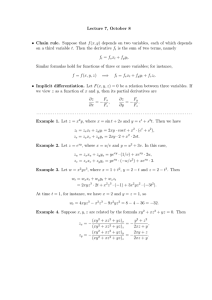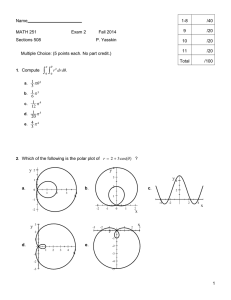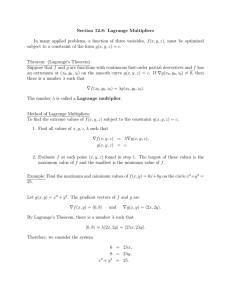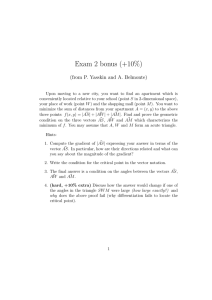MATHEMATICS 200 December 2003 Final Exam Solutions
advertisement
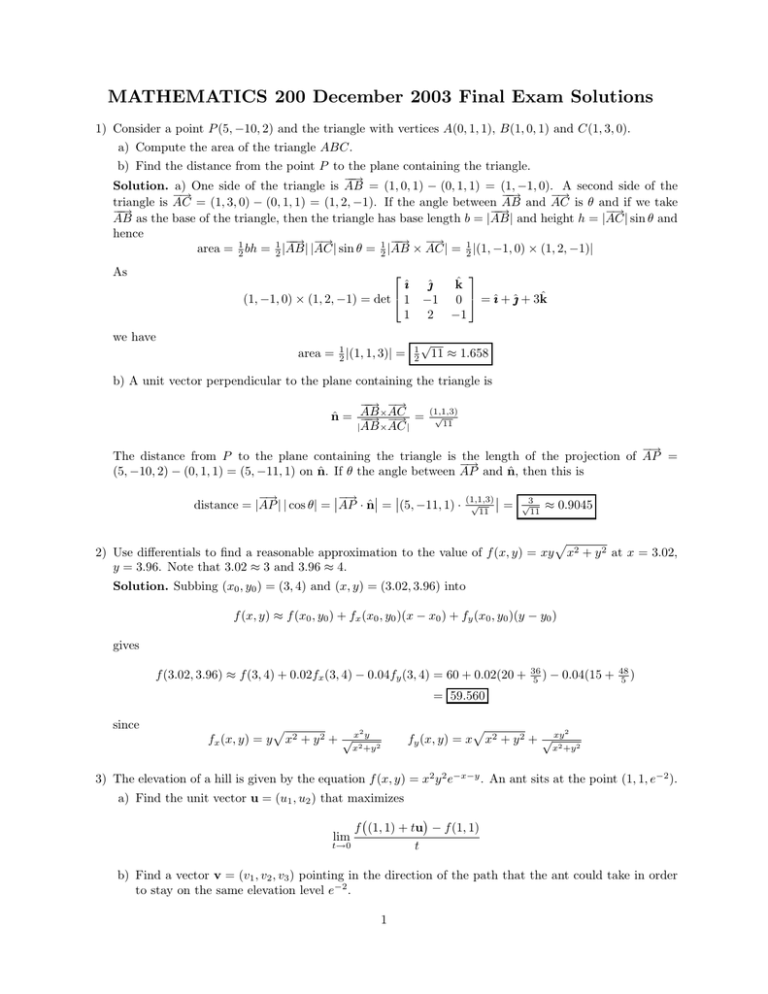
MATHEMATICS 200 December 2003 Final Exam Solutions 1) Consider a point P (5, −10, 2) and the triangle with vertices A(0, 1, 1), B(1, 0, 1) and C(1, 3, 0). a) Compute the area of the triangle ABC. b) Find the distance from the point P to the plane containing the triangle. −−→ Solution. a) One side of the triangle is AB = (1, 0, 1) − (0, 1, 1) = (1, −1, 0). A second side of the −→ −−→ −→ triangle is AC = (1, 3, 0) − (0, 1, 1) = (1, 2, −1). If the angle between AB and AC is θ and if we take −−→ −−→ −→ AB as the base of the triangle, then the triangle has base length b = |AB| and height h = |AC| sin θ and hence −−→ −→ −−→ −→ area = 21 bh = 12 |AB| |AC| sin θ = 12 |AB × AC| = 21 |(1, −1, 0) × (1, 2, −1)| As ı̂ı (1, −1, 0) × (1, 2, −1) = det 1 1 ̂ −1 2 we have area = 12 |(1, 1, 3)| = 1 2 √ k̂ 0 = ı̂ı + ̂ + 3k̂ −1 11 ≈ 1.658 b) A unit vector perpendicular to the plane containing the triangle is −−→ −→ ×AC n̂ = AB −−→ −→ = |AB ×AC | (1,1,3) √ 11 −→ The distance from P to the plane containing the triangle is the length of the projection of AP = −→ (5, −10, 2) − (0, 1, 1) = (5, −11, 1) on n̂. If θ the angle between AP and n̂, then this is −→ −→ distance = |AP | | cos θ| = AP · n̂ = (5, −11, 1) · (1,1,3) √ 11 = √3 11 ≈ 0.9045 2) Use differentials to find a reasonable approximation to the value of f (x, y) = xy y = 3.96. Note that 3.02 ≈ 3 and 3.96 ≈ 4. Solution. Subbing (x0 , y0 ) = (3, 4) and (x, y) = (3.02, 3.96) into p x2 + y 2 at x = 3.02, f (x, y) ≈ f (x0 , y0 ) + fx (x0 , y0 )(x − x0 ) + fy (x0 , y0 )(y − y0 ) gives f (3.02, 3.96) ≈ f (3, 4) + 0.02fx (3, 4) − 0.04fy (3, 4) = 60 + 0.02(20 + 36 5 ) − 0.04(15 + 48 5 ) = 59.560 since fx (x, y) = y p 2 x2 + y 2 + √ x2 y fy (x, y) = x x +y 2 p x2 + y 2 + √ xy2 2 x +y 2 3) The elevation of a hill is given by the equation f (x, y) = x2 y 2 e−x−y . An ant sits at the point (1, 1, e−2 ). a) Find the unit vector u = (u1 , u2 ) that maximizes f (1, 1) + tu − f (1, 1) lim t→0 t b) Find a vector v = (v1 , v2 , v3 ) pointing in the direction of the path that the ant could take in order to stay on the same elevation level e−2 . 1 c) Find a vector v = (v1 , v2 , v3 ) pointing in the direction of the path that the ant should take in order to maximize its instantaneous rate of level increase. (1,1) Solution. a) The expression limt→0 f ((1,1)+tu)−f is the directional derivative of f at (1, 1) in the t direction u, which is Du f (1, 1) = ∇f (1, 1) · u. This is mazimized when u is parallel to ∇f (1, 1). Since fx (x, y) = 2xy 2 e−x−y − x2 y 2 e−x−y the desired unit vector u is fy (x, y) = 2x2 ye−x−y − x2 y 2 e−x−y =⇒ ∇f (1, 1) = e−2 (1, 1) √1 (1, 1) . 2 −2 b) In order to remain at elevation e , the ant must move so that Du f (1, 1) = 0. This is the case if u ⊥ ∇f (1, 1). For example, we can take u = (1, −1). When the ant moves in this direction, while remaining on the surface of the hill, its vertical component of velocity is zero. So v = c(1, −1, 0) for any nonzero constant c. c) In order to maximize its instantaneous rate of level increase, the ant must choose the x and y coordinates of its velocity vector in the same direction as ∇f (1, 1). Namely u = c(1, 1) for any c > 0. To make u a unit vector, we choose c = √12 . The corresponding value of the z coordinate of its velocity vector is the rate of change of f per unit horizontal distance travelled, which is the directional derivative Du f (1, 1) = ∇f (1, 1) · u = e−2 (1, 1) · (c, c) = 2ce−2 So v = √1 (1, 1, 2e−2 ) 2 . Any positive multiple of this vector is also a correct answer. 4) Find all critical points of the function f (x, y) = x4 + y 4 − 4xy + 2, and for each determine whether it is a local minimum, maximum or saddle point. Solution. We have f (x, y) = x4 + y 4 − 4xy + 2 fx (x, y) = 4x3 − 4y fxx (x, y) = 12x2 fy (x, y) = 4y 3 − 4x fyy (x, y) = 12y 2 fxy (x, y) = −4 At a critical point fx (x, y) = fy (x, y) = 0 ⇐⇒ y = x3 and x = y 3 ⇐⇒ x = x9 and y = x3 ⇐⇒ x(x8 − 1) = 0, y = x3 ⇐⇒ (x, y) = (0, 0) or (1, 1) or (−1, −1) Here is a table giving the classification of each of the three critical points. critical point 2 fxx fyy − fxy fxx 2 type (0, 0) 0 × 0 − (−4) < 0 (1, 1) 12 × 12 − (−4)2 > 0 12 local min (−1, −1) 12 × 12 − (−4)2 > 0 12 local min saddle point 5) A closed rectangular box with a volume of 96 cubic meters is to be constructed of two materials. The material for the top costs twice as much per square meter as that for the sides and bottom. Use the method of Lagrange multipliers to find the dimensions of the least expensive box. Solution. Let the box have dimensions x × y × z. Use units of money so that the sides and bottom cost one unit per square meter and the top costs two units per square meter. Then the top costs 2xy, the bottom costs xy and the four sides cost 2xz + 2yz. We are to find the x, y and z that minimize the cost C(x, y, z) = 2xy + xy + 2xz + 2yz subject to the constraint that xyz = 96. Set f (x, y, z, λ) = C(x, y, z) − λ(xyz − 96) = 3xy + 2xz + 2yz − λ(xyz − 96) 2 Then fx = 3y + 2z − yzλ = 0 fy = 3x + 2z − xzλ = 0 fz = 2x + 2y − xyλ = 0 fλ = xyz − 96 =0 Multiplying the first equation by x, the second equation by y and the third equation by z and then subbing in xyz = 96 gives 3xy + 2xz − 96λ = 0 3xy + 2yz − 96λ = 0 2xz + 2yz − 96λ = 0 Subtracting the second equation from the first gives 2z(x − y) = 0. Since z = 0 is impossible, we must have x = y. Subbing this in 3x2 + 2xz − 96λ = 0 4xz − 96λ = 0 Subtracting 3x2 − 2xz = 0 =⇒ z = 23 x =⇒ 96 = xyz = 32 x3 =⇒ x3 = 64 =⇒ x = y = 4, z = 6 meters 6) Consider the solid under the surface z = 6 − xy, bounded by the five planes x = 0, x = 3, y = 0, y = 3, z = 0. Note that no part of the solid lies below the x–y plane. a) Sketch the base of the solid in the x–y plane. Note that it is not a square! b) Compute the volume of the solid. Solution. a) The solid is the set of all (x, y, z) obeying 0 ≤ x ≤ 3, 0 ≤ y ≤ 3 and 0 ≤ z ≤ 6 − xy. The base of this region is the set of all (x, y) for which there is a z such that (x, y, z) is in the solid. So the base is the set of all (x, y) obeying 0 ≤ x ≤ 3, 0 ≤ y ≤ 3 and 6 − xy ≥ 0. This region is sketched below. y x=3 (2,3) y=3 xy = 6 x 2 b) Z 2 volume = Z Z 2 0 Z = 0 3 dx 6y − 21 xy 2 0 + 2 dx 18 − 29 x + Z Z 2 3 dy (6 − xy) 2 0 6/x dx 6y − 21 xy 2 0 3 dx 2 6/x Z dx 0 = 3 Z dy (6 − xy) + dx 0 3 36 x − 18 x 2 3 = 18x − 94 x2 0 + 18 ln x 2 = 27 + 18 ln 32 ≈ 34.30 7) A sphere of radius 2m has variable density the sphere along the z–axis. √5 (z 2 3 + 1)kg/m3 . A hole of diameter 1m is drilled through a) Set up a triple integral in cylindrical coordinates giving the mass of the sphere after the hole has been drilled. b) Evaluate this integral. 3 Solution. The statement of this question is incomplete. The centre of the sphere is not specified. I think that it was intended that the centre be at the origin. In cylindrical coordinates the equation of a sphere of radius 2 centred on the origin is r2 + z 2 = 22 . Since dV = r drdθdz and dm = √53 (z 2 + 1)r drdθdz and the hole has radius 1/2, the integral is mass = R2 dr 1/2 R √4−r2 √ − 4−r 2 dz R 2π 0 dθ √5 (z 2 3 + 1)r = 4π √53 = 4π √53 = 4π √53 Z √ 2 Z 4−r 2 dz (z 2 + 1) dr r 1/2 Z 2 0 dr r z3 dr r 1 1/2 2 Z 1/2 3 +z 3 (4 √4−r2 0 − r2 ) 3/2 1/2 + (4 − r2 ) Make the change of variables s = 4 − r2 , ds = −2r dr. This gives mass = = Z 4π √53 0 15/4 1 2π √53 16 + ds −2 1 12 3/2 3s 1 2 5/2 2 3/2 0 2 155/2 = 2π √53 15 + s1/2 = −2π √53 15 s + 3s 32 + 15/4 3/2 15 = 525 24 √ 2 153/2 3 8 5π ≈ 153.7kg 8) A particle P of unit mass whose position in space at time t is r(t) has angular momentum L(t) = r(t) × r0 (t). If r00 (t) = ρ(t)r(t) for a scalar function ρ, show that L is constant, i.e. does not change with d . time. Here 0 denotes dt Solution. dL dt = d dt r(t) × r0 (t) = r0 (t) × r0 (t) + r(t) × r00 (t) = r0 (t) × r0 (t) + r(t) × ρ(t)r(t) Both terms vanish because the cross product of any two parallel vectors is zero. So independent of t. 4 dL dt = 0 and L(t) is
